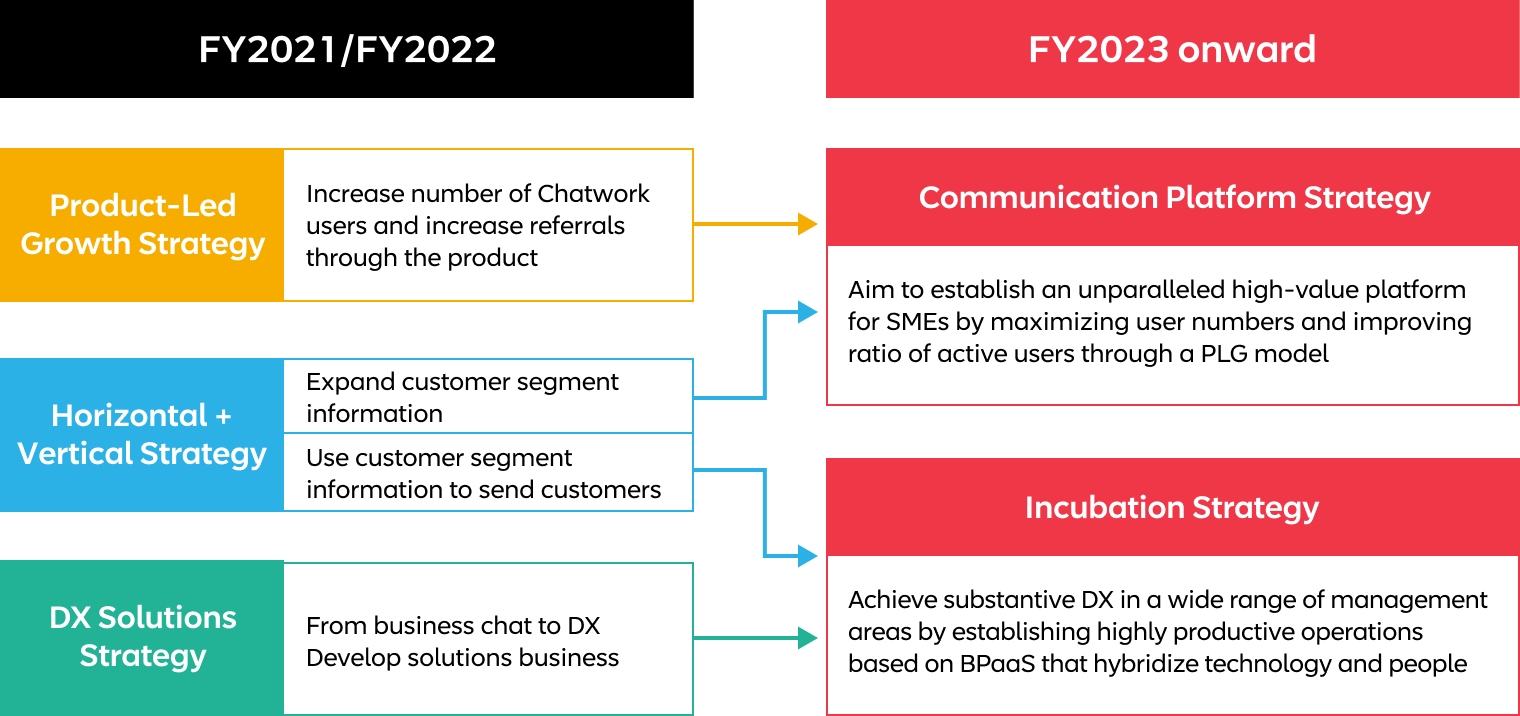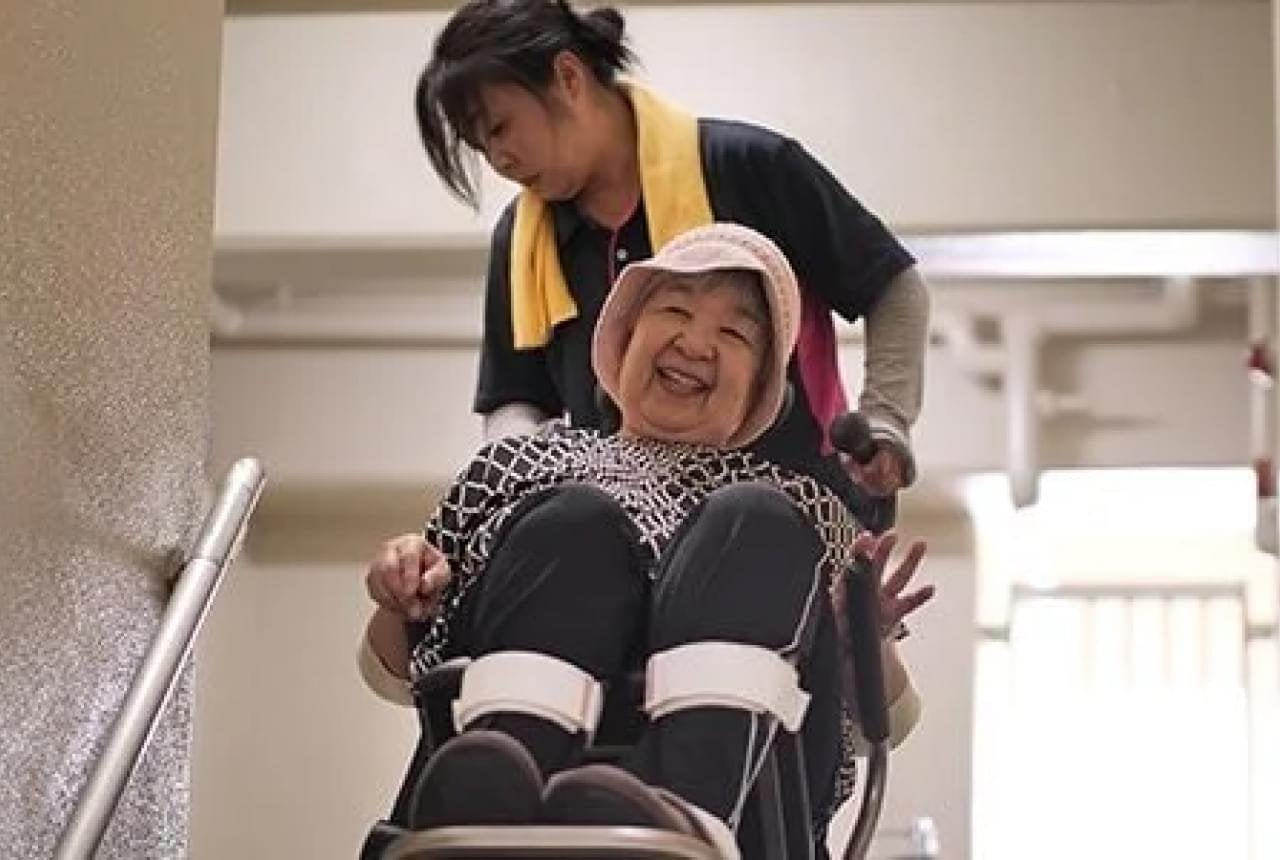Improving Labor Productivity at SMEs through DX

Goals toward Achieving the SDGs
Goals and KPI
- 2030 Goal
- Create solutions that enable anyone to move forward through our business platform, which serves as a base for digitalization and DX, and help achieve sustainable management, primarily at SMEs
- 2024 Goal
- Make a significant contribution to improving the efficiency of business communication in Japan through our business chat service, which has the number one market share among SMEs, and increase support for DX based on this contribution
- 2030 KPI
-
Number of Japanese SMEs using our business platform: over 1 million companies
*Our business platform refers to Chatwork and a suite of services related to DX solutions based on the use of Chatwork.
Approach and System
Chatwork's Value and Strategies
There are believed to be more than 3.5 million small- and medium-sized enterprises in Japan*1, accounting for 99.7% of all enterprises and approximately 53% of total added value in Japan*2. The productivity of SMEs must be maintained and improved in order to revitalize the Japanese economy.
At the same time, digital transformation (DX), which utilizes digital technologies including AI, IoT, and big data to transform people's lives for the better, is beginning to spread throughout the world. We are entering an era in which DX will play an important role in improving both corporate competitiveness and productivity.
However, while 76% of SMEs are aware of the need for DX, only 7.9% of companies are working on it, with an additional 16.9% of companies considering its implementation*3. In addition, many SMEs are struggling to tackle issues related to DX on their own, including lack of budget, human resources, and knowledge to advance DX/IT, lack of visible effects and results, not knowing where to start, and difficulty in ensuring information security.
We have been offering Chatwork, a business communication tool that replaces telephone calls and e-mails, since 2011, and it is currently being used at more than 386,000 companies*4. Chatwork has contributed to revitalizing communicating and improving labor productivity at business sites by providing a more advanced service that is easy to implement, even for SMEs. It boasts both a user-friendly design that anybody can use, as well as an affordable price that even SMEs can continue to pay.
Furthermore, Chatwork facilitates business by making it easy to connect with business partners both inside and outside of the company with a single account. This gives Chatwork the unique feature of acquiring new customers through introductions from existing users. It also possesses excellent platformability, with overwhelming user contact points as users in all industries continue to use it throughout their workdays.
We want to leverage these features to contribute not only to productivity improvement at SMEs, but also to the resolution of management issues at SMEs in Japan by building a DX advancement platform based on Chatwork. As such, in April 2021, we launched a DX advancement platform called the "DX Advisory Service."
This service provides dedicated DX advisors who cover a wide range of business domains to discuss the issues that users are facing, propose DX solutions to help resolve these issues, and support their introduction and utilization. As of October 2022, the number of partner companies has exceeded 35, with more than 14,000 consultations, further accelerating the use of DX.
These services not only help solve issues through DX, but also free up time for companies to focus on high-value operations and create even better value by externalizing and streamlining operations that do not necessarily need to be tackled in-house.
In this way, we strive to use our business to help improve productivity and value creation at Japanese SMEs, which have long been regarded as sluggish, and achieve the society we are aiming for in our sustainability vision.
*1 2019 White Paper on Small and Medium Enterprises in Japan
*2 2022 White Paper on Small and Medium Enterprises in Japan
*3 Organization for Small & Medium Enterprises and Regional Innovation, JAPAN, "Survey on DX Promotion at Small & Medium Enterprises (2022)"
*4 As of December 31, 2022
Value Provided by Our Services

We launched the corporate venture capital "Chatwork Super App Fund" in fiscal year 2022 to accelerate the growth of this platform. This fund invests in business partners that share our customer attributes to support their growth, referring Chatwork users in need of services to these partners in order to create win-win synergies and accelerate the platform's expansion.
We will use this DX advancement platform as a base to create "Super Apps for Business*" that provide all the services necessary to resolve problems at SMEs going forward, thereby contributing to the sustainable growth of SMEs in Japan.
Click here for the DX Consultation Service
*Applications that serve as a foundation for providing applications with various functions from a single platform
Chatwork's Main Initiatives
We have positioned the period up to 2024 as an important phase for expanding our market share to create Super Apps for Business. Accordingly, we have been accelerating our growth through three strategies.
The first strategy is the "Product-Led Growth Strategy," which aims to expand the number of Chatwork users by leveraging referrals from existing customers. The second strategy is the "Horizontal + Vertical Strategy," which aims to deepen usage of Chatwork and solve industry issues. The third strategy is the "DX Solutions Strategy," which aims to use Chatwork's platformability to increase DX at SMEs.
In addition, we updated our current Medium-Term Business Plan at the end of 2022, re-organizing these three strategies down to two based on the knowledge we have gained over the past two years. The first strategy is the "Communication Platform Strategy," which aims to deepen usage of business chat and establish a high-value platform to maximize user numbers and utilization. The second strategy is the "Incubation Strategy," which enables the development of various businesses on the platform.
Two Strategies in the New Medium-Term Business Plan (2023 Onward)

Below are examples of value creation and comments by employees working toward the achievement of these strategies.
Comments by Employees Tackling Productivity Improvement at SMEs
Value Creation in the "Sagrada Project" for Product Infrastructure Development
"Developing business infrastructure that stably processes vast amounts of customer information and creates value for customers"

More than 10 years have passed since the launch of Chatwork, and it has become a type of social infrastructure. However, there were technical issues that needed to be improved at the basic design level as a result of expanding the service while improvements were still being made. We therefore launched the "Sagrada Project" to revamp our core system to improve our product and organization in line with future business plans.
Now that Chatwork is being used by many people, it has become very challenging to respond to the non-functional requirements demanded by users, such as performance and availability. It is difficult to rewrite programs and add new functions as non-functional requirements must always be met. However, I want us to provide even more value to the world through Chatwork, which has become an even better product.
Yoshitaka Fujii
Product Infrastructure Development Department, Product Division
Providing Value through Usability Assessment and Improvement
"Offering services that are simple and easy to use, even for those without IT experience"

The Product Design Department is working on active user understanding and design proposals to achieve our corporate vision of "empowering everyone to work a step ahead." As business chat becomes more and more popular, a thorough understanding of customers and the flexible incorporation of this understanding into product design are essential to create simple and easy designs that anyone can use and that can be connected both inside and outside the company.
As part of this process, we continuously conduct expert reviews whereby experts assess the appropriateness of the UI, which is the point of contact with users. Two teams, one for accessibility and one for usability, assess the usability of products using different methods. We also continue to improve usability by resolving any UI issues we identify in order to offer services that can be used by everyone.
Yukiko Motegi
Product Design Department, Product Division
Providing Value Based on Deep Industry Understanding
"Understanding industry challenges and helping to solve them with Chatwork"

The Sales and Customer Success Unit is divided into four departments: "Inside Sales," which is responsible for initial contact with customers; "Field Sales," which is responsible for negotiating and closing deals; "Customer Success," which works closely with Chatwork users to encourage service use and improve business efficiency; and "Partner Sales," which conduct these activities with sales partners. All of these departments work together to expand Chatwork use among SMEs and help resolve their problems.
Many Chatwork users have little experience with IT and SaaS products, having signed up at the request of business partners with little idea of how to use it. In addition, while Chatwork is used as a business chat tool in all industries and sectors, it may need to be altered and customized to meet the specific challenges of each industry. Therefore, I want us to help solve user issues by gaining a deeper understanding of their situations and industries and proposing ways to use Chatwork that are specific to their company and industry.
Yosuke Iida
Sales and Customer Success Unit, Communication Platform Division
Examples of Problem Solving Using Chatwork
Nakatsu Daiichi Hospital
"Showing its true value by responding to COVID-19 cases at hospitals! What once took one month can now be done in two weeks"

Problems
- Intranet construction was being considered to improve information sharing efficiency, but the project stalled
- Communication by telephone, e-mail, and fax each had unique problems
- Problems were occurring when sharing information during emergencies, such as responding to COVID-19
Solutions
- Introduced Chatwork instead of intranet
- Created a group chat system exclusively for COVID-19 to communicate during emergencies
Effects
- Even staff unfamiliar with digital technology could use Chatwork without issue, improving information sharing efficiency within the hospital
- Problems related to telephone, e-mail, and fax were all solved through Chatwork
- Information handling became smoother, reducing the time required to wrap up cluster occurrences by half
User Comments
We used to rely on telephones, email, and fax for information sharing. Phone calls can convey information in real time, but they take up the other party's time. Email allows for information to be shared and checked at your convenience, but the information is not organized, and important information could end up buried. Faxes are not always received by their intended recipient and there is a time lag before information is conveyed. Also, if the person who receives the information doesn't understand its importance, it may be difficult to deliver that information to its intended recipient as quickly as it needs to be.
Chatwork was the solution to these problems. Information can be shared without taking up the other party's time, and since it is organized by group chat, it doesn't get buried under other information. It also prevents communication errors as information is delivered directly to the people who need to receive it.
One unexpected benefit of introducing Chatwork was responding to COVID-19 cases. The number of infected patients exploded after the Omicron variant emerged, and this led to infections among hospital staff members as well. Some of our patients are elderly, so we have to be careful when responding to them after infection.
We therefore created both a group chat dedicated to responding to COVID-19 cases and a system to share information on infections within the hospital. When we learned that a staff member had been infected or in close contact with an infected patient, we shared information on locations in the hospital that had been visited by that staff member as well as their activity history outside the hospital via Chatwork to identify those who came into close contact and establish an inspection system. Furthermore, even after infected people were put into isolation at home, management information such as body temperature and physical condition was shared via Chatwork, enabling their smooth return to work. Thanks to Chatwork, we were able to reduce the time required to deal with COVID-19 cases to two weeks, whereas it would normally have taken a month. We couldn't have done that without Chatwork.
Nakatsu Daiichi Hospital (https://www.nakatsu-daiichi.jp/)
A medical institution in Nakatsu City, Oita Prefecture that provides various medical services including urology, internal medicine, gastroenterology, nephrology (dialysis), diabetology, surgery, plastic surgery, and rehabilitation medicine, as well as home rehabilitation, home nursing, and in-home medical care.
SCC Osaka Co., LTD.
"Achieving stress-free ICT implementation in the field and doubling productivity per hour"

Problems
- Free time in between home care assignments was being wasted
- Omissions were occurring in the daily sharing of information about patients
- Staff needed to gather in order to communicate with each other
Solutions
- Created a group chat for each patient, including the helper in charge
- Created a paperless system by replacing audit-related documents with Chatwork
- Enabled information sharing and communication even from outside the office via Chatwork
Effects
- Even helpers who have to go on short notice are able to handle situations without compromised service quality
- Time spent preparing documents for audits has been greatly reduced
- A culture of helping one another was created, allowing staff members to work positively with each other
User Comments
We started considering the introduction of ICT to take advantage of our helpers' free time in between appointments. Home care services are provided by visiting users at their homes, so there is always travel time. Returning to the office between appointments can take up a lot of time, but not returning to the office can create extra free time.
In addition, not returning to the office makes smooth communication between service providers challenging, making it difficult to communicate in the office. We urgently needed to reduce the burden on managers and office staff by using ICT to reduce data entry tasks, such as transcribing paper service implementation records into nursing care software.
Introducing Chatwork has measurably improved our productivity. Before Chatwork, the hourly productivity of staff involved in administrative work, including managers and office staff, was 1,615 yen. However, this hourly rate almost doubled to 3,121 yen for the past three months since Chatwork's introduction. We've been able to increase operating revenue while minimizing the time spent on administrative work.
In addition, helpers have stated that Chatwork makes it easier to share information and do their work, helping to reduce turnover rate. We have created group chats based on feedback from frontline workers, such as helper training, helper dispatch lists, close calls, and signatures. Many tasks can now be completed online, making operations more efficient. The introduction of Chatwork has also enabled us to incorporate the opinions of those on the frontlines who want to make certain improvements more easily.
SCC Osaka Co., LTD. (https://www.scc.osaka.jp/)
Founded in 1992 as an osteopathic clinic. Incorporated in 2000, launched a nursing care business in 2011, and an IT business in 2018. Currently operates one osteopathic clinic, one home care station, and one coworking space.


